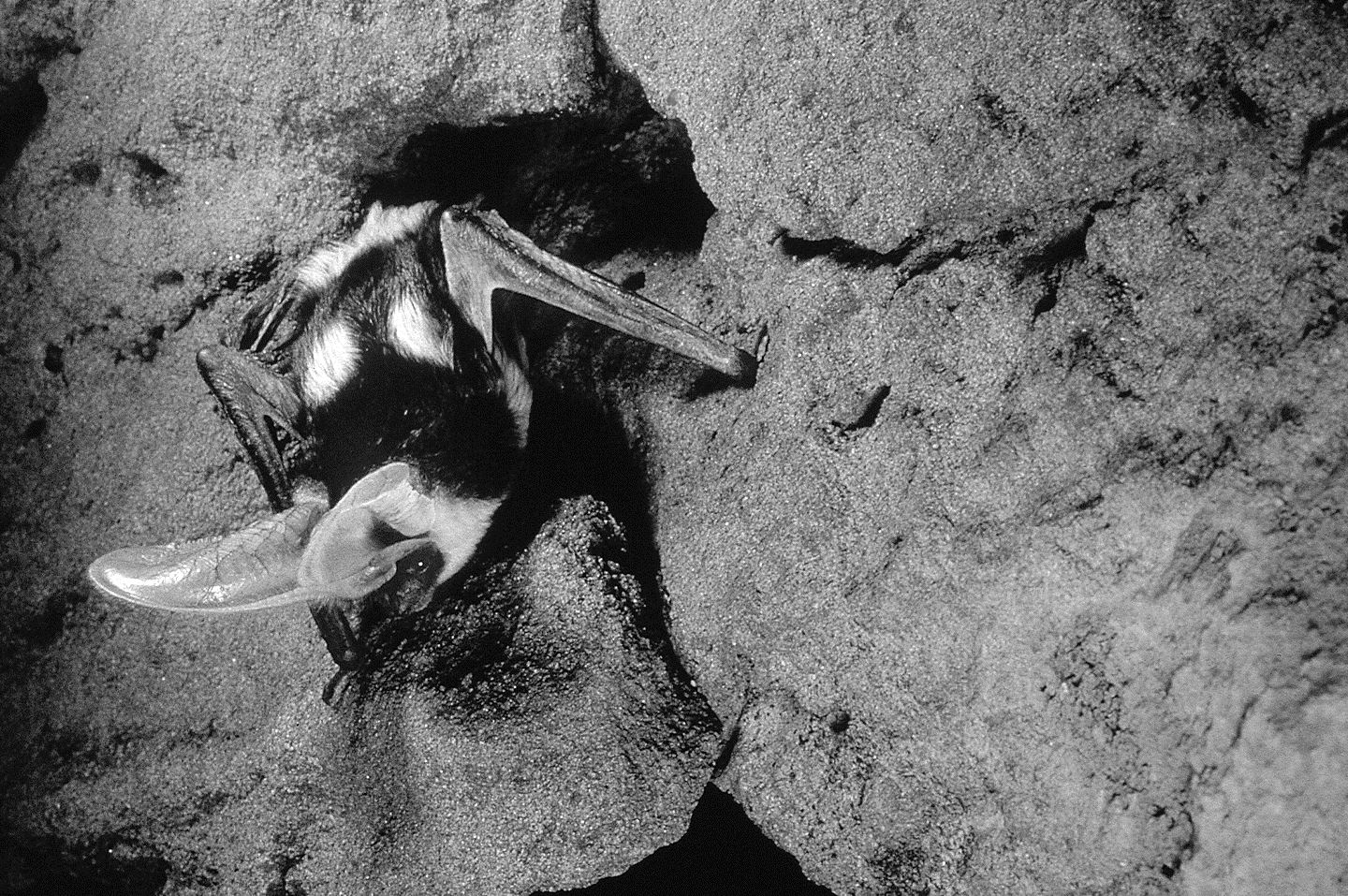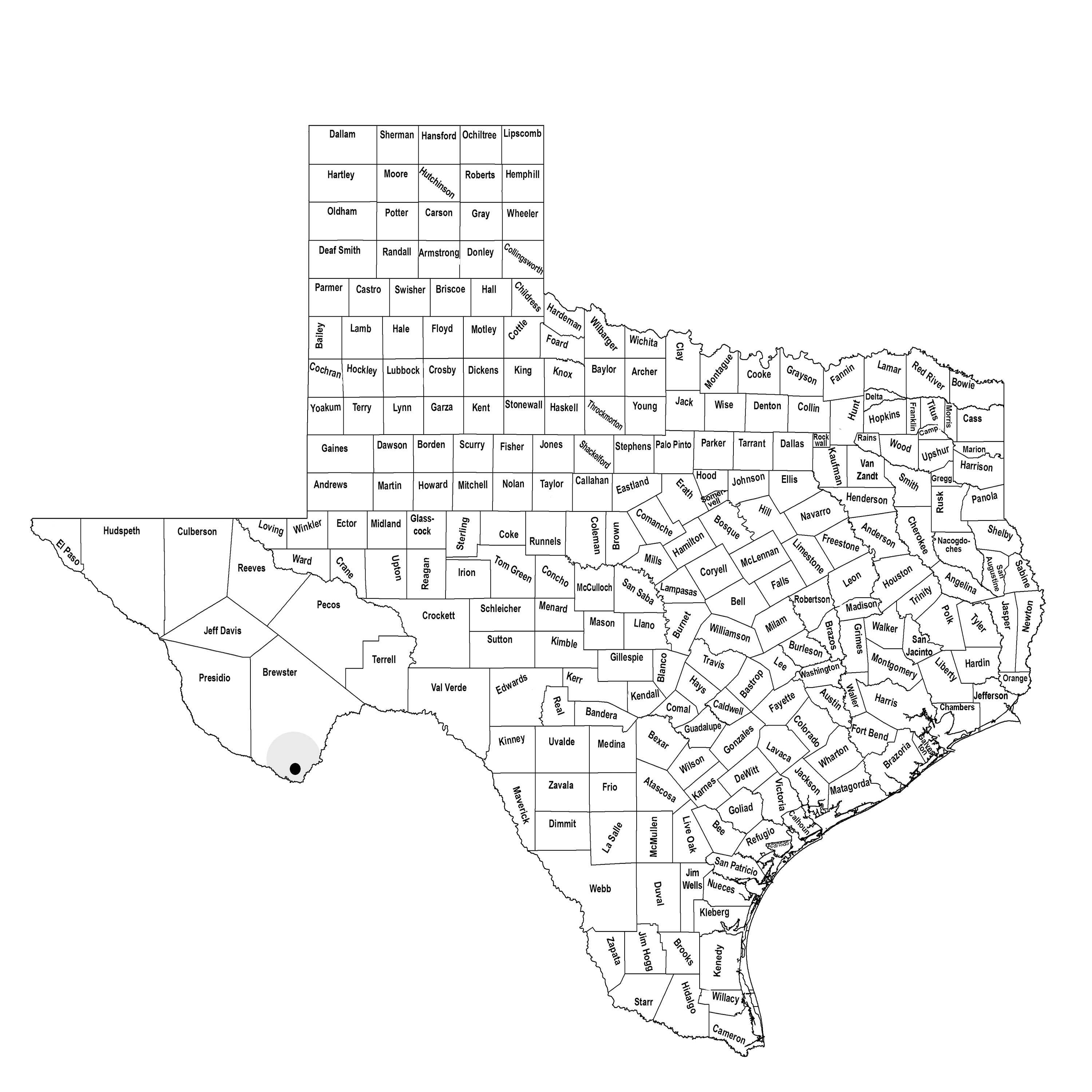SPOTTED BAT
Euderma maculatum (J. A. Allen 1891)
Order Chiroptera : Family Vespertilionidae
DESCRIPTION. A moderately large bat with extremely large ears and a conspicuous dorsal color pattern of three large white spots, one on each shoulder and one on the rump, on a black background; a small white patch at the base of each ear; hairs on the underparts with white tips and blackish bases. Ears and membrane in living individuals pinkish; pale brownish in preserved specimens. Dental formula: I 2/3, C 1/1, Pm 2/2, M 3/3 × 2 = 34. Averages for external measurements: total length, 124 mm; tail, 51 mm; ear, 42 mm; forearm, 51 mm; foot, 12 mm. Weight, 16–20 g.

DISTRIBUTION. The spotted bat is known from semiarid regions of the western United States and northern Mexico from southwestern Idaho and south-central Montana southward to the Mexican states of Durango and Queretaro. It is known in Texas only from specimens captured in Big Bend National Park, Brewster County, where it was first recorded in 1967. Additional specimens have since been obtained from several localities within Big Bend National Park, but no specimens have been captured outside the park.

SUBSPECIES. Monotypic species.
HABITS. Although unmistakable in appearance, the spotted bat is one of the least understood of North American bats, primarily because of its relative scarcity, at least in collections. There have been scattered records of this bat throughout the western United States dating back to 1891, but it has been taken with any regularity only in California, Arizona, New Mexico, southern Utah, and southern Colorado. It was first found in Texas by David Easterla, who in early August 1967 captured two adult females in mist nets set above a pool in a shallow, barren, hot, dry canyon in Big Bend National Park.
The infrequency of capture of this bat has caused much confusion and speculation regarding its habitat. Several authors have reported captures in pine forests at high elevations (2,400 m); others from a pinyon pine–juniper association, and still others from open scrub associations in desert areas. One worker has suggested that females give birth to their young in forested situations and later move to the lower elevations; another suggests that the bat is a cliff dweller and roosts in cracks and crevices of canyon walls. A large number of the known specimens were captured in mist nets set over permanent streams or water holes adjacent to steep cliffs in open scrub desert country. Spotted bats favor the crevices found in vertical cliff faces as roosting sites but also have been documented roosting in caves, mines, and buildings.
Little is known of the behavior of the spotted bat except that it appears to be most active well after dark. Most individuals caught in mist nets set over water, where bats come to drink, have been captured after midnight. Easterla speculated that its swoop over a water hole is made at relatively high speeds because several of the bats he has captured have been injured when they struck the nets. While in flight the bat emits a series of strident tics similar to, but higher pitched than, those of Allen's big-eared bat, Idionycteris phyllotis. Several authors have commented on the docile disposition of captive spotted bats, but occasional individuals are ill tempered. Available data indicate that these bats are unquestionably moth specialists, as moths constitute nearly 100% of their diet. They also may consume an occasional beetle or true bug.
Data on reproduction are sparse. A gravid female captured by Easterla on 11 June in Big Bend National Park gave birth a few hours later to a single male baby that weighed 4 g (one-fourth of his mother's weight!). One of two females Easterla captured in the park in early August was lactating; the other was in a postlactating condition. Two females captured 30 June and 1 July in Catron County, New Mexico, were in postpartum condition and lactating, as were three females collected in Garfield County, Utah, in mid-August. Thus, it appears that a single offspring is born to each sexually active female in June or July. The young are altricial and lack the characteristic spotted color pattern of the adults.
POPULATION STATUS. Rare, summer resident. In spite of a fairly wide range in the United States, the spotted bat is one of the least known of North American bats because it is infrequently captured due to its habit of flying and foraging high above the ground. In Texas, this species has been captured only in Big Bend National Park in Brewster County, where it was first recorded in 1967. Two additional specimens were captured in the Park in 1997 and 1998, but none have been obtained from outside this area.
CONSERVATION STATUS. The IUCN status of the spotted bat is least concern. The restricted range of the bat, and small number of captures in Texas, accounts for its listing by TPWD as threatened. The USFWS has adopted the position that more information is needed before any type of endangered or threatened listing should be considered.
From The Mammals of Texas, Seventh Edition by David J. Schmidly and Robert D. Bradley, copyright © 1994, 2004, 2016. Courtesy of the University of Texas Press.
Natural Science Research Laboratory
-
Address
Museum of Texas Tech University, 3301 4th street, Lubbock, TX 79409 -
Phone
806.742.2486 -
Email
nsrl.museum@ttu.edu

